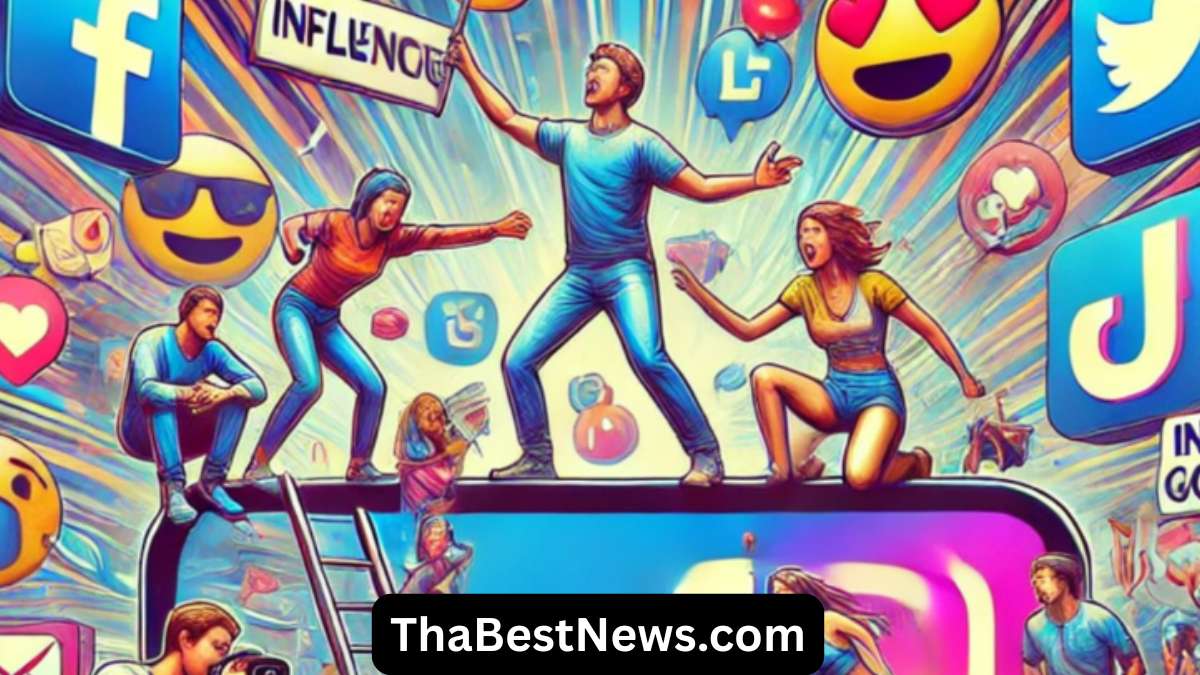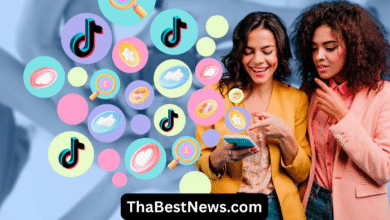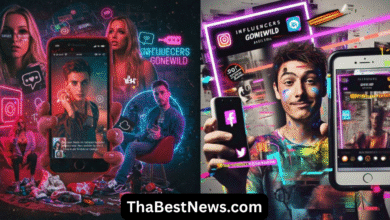InfluencersGoneWild In the vast and ever-evolving landscape of social media, the term “influencersgonewild” has begun to capture public attention with a mix of intrigue, controversy, and cultural significance. This phrase embodies a growing trend where social media influencers push boundaries, often sharing content that is more daring, provocative, or unfiltered than their usual posts. It is a phenomenon that has sparked conversations about authenticity, digital fame, and the pressures of maintaining an online persona in today’s hyper-connected world.
The concept of influencers gone wild taps into a broader narrative about how social media platforms shape identity and behavior. As millions of users scroll through Instagram, TikTok, YouTube, and other sites, they witness influencers who blur the lines between public and private life, reality and performance. These influencers often adopt bolder personas, embrace controversy, and sometimes engage in behaviors that challenge social norms or expectations.
This article delves into the meaning behind “influencersgonewild,” explores why influencers might choose to take their content to new extremes, and considers the impact this trend has on their followers and the social media ecosystem as a whole.
The Rise of the Influencer Culture and Its Impact
To understand the “influencersgonewild” phenomenon, it’s essential to first look at the rise of influencer culture itself. Social media influencers emerged as a new type of celebrity — individuals who build significant followings through relatable content, lifestyle sharing, expertise, or entertainment value. Unlike traditional celebrities, influencers often create their own brands, engage directly with fans, and cultivate intimate connections that feel personal and authentic.
This culture has revolutionized marketing and communication, giving rise to micro-celebrities who can sway consumer behavior, set trends, and even influence social issues. However, with fame comes pressure. Influencers often face the challenge of keeping their audience engaged, maintaining relevance, and standing out in a crowded digital space.
The allure of viral fame and the financial rewards associated with large followings can incentivize some influencers to adopt more extreme tactics. This can include provocative photo shoots, candid or controversial opinions, or participation in challenges and trends that push limits. The hashtag or term “influencersgonewild” encapsulates this leap from curated, polished posts to more uninhibited, raw, or attention-grabbing content.
What Does “InfluencersGoneWild” Really Mean?
At its core, “influencersgonewild” refers to influencers who step outside their usual content style and venture into bolder territory. This can take many forms, including sharing more risqué images, engaging in outrageous stunts, revealing behind-the-scenes moments that break social taboos, or simply acting more candidly and spontaneously than ever before.
For many influencers, this shift is a strategic decision. The digital ecosystem rewards engagement — and shock value, controversy, or unpredictability often generate substantial attention. By going “wild,” influencers can capitalize on curiosity, tap into viral trends, and increase their visibility. It also allows them to differentiate themselves in a market saturated with polished, often homogeneous content.
However, this approach is not without risks. Going too far can alienate audiences, invite negative backlash, or even damage personal brands. It raises questions about the fine line between authenticity and spectacle, and how much of what is shared is genuine versus performance.
The Psychological and Social Dynamics Behind Going Wild
The decision for influencers to go wild can also be understood through psychological and social lenses. Influencers exist in a unique environment where their sense of self is continuously shaped by digital feedback loops. Likes, comments, shares, and followers serve as immediate social validation, creating both incentives and pressures to perform.
This dynamic can foster a desire to take greater risks in content creation to sustain or boost engagement. Some influencers might experience “performance fatigue” from maintaining a perfect, polished persona and turn to more raw, uninhibited content as a form of release or reinvention.
Socially, going wild may also be a way to challenge or subvert conventional norms around beauty, behavior, or morality. For some influencers, it is a deliberate act of self-expression or activism, using their platforms to break taboos and provoke dialogue. For others, it can be a way to connect more deeply with followers who seek more honest, unfiltered glimpses into life.
The Role of Platforms in Shaping Influencers’ Behavior
Social media platforms themselves play a significant role in the rise of influencers gone wild. Algorithms that prioritize engagement tend to favor content that elicits strong emotional reactions, whether positive or negative. Controversial or shocking content often gains more visibility, creating an environment where influencers are encouraged, implicitly or explicitly, to push boundaries.
Additionally, the design of platforms enables constant content sharing, immediate feedback, and viral potential, all of which can escalate the pace and intensity of influencer behavior. The competition for attention drives some creators to experiment with riskier content to maintain or grow their presence.
At the same time, platforms maintain community guidelines and policies that attempt to balance freedom of expression with safety and decency. Influencers who go too wild sometimes face account suspensions, demonetization, or public criticism, illustrating the tension between creative freedom and platform governance.
The Cultural Impact and Controversies Surrounding InfluencersGoneWild
The “influencersgonewild” trend reflects broader cultural shifts around fame, identity, and media consumption. It challenges traditional ideas about celebrity behavior, privacy, and the role of media in shaping public discourse.
On one hand, this trend can be seen as empowering, offering influencers the chance to express their authentic selves and challenge social conventions. It can democratize fame by breaking down polished, curated images and allowing more diverse voices and experiences to surface.
On the other hand, it can fuel sensationalism, superficiality, and even harmful behavior. The desire for clicks and views can sometimes lead to exploitation, mental health challenges, or the blurring of ethical lines. Critics argue that the pressure to go wild might encourage unsafe stunts or unhealthy standards, especially among younger audiences who look up to influencers as role models.
The media often amplifies controversies involving influencers gone wild, which can reinforce stereotypes or stigmatize the influencer community as a whole. This complex dynamic raises important questions about responsibility, both on the part of influencers and their audiences.
Economic Drivers Behind the Wild Side of Influencing
Monetization opportunities are a powerful driver behind why some influencers choose to go wild. Brand partnerships, sponsorships, and advertising deals often depend on visibility and engagement metrics. Content that is daring or edgy can generate significant buzz, translating into financial gain.
For some influencers, going wild is a calculated business strategy designed to accelerate follower growth, increase media attention, or attract niche audiences. This is especially true in highly competitive niches such as fashion, beauty, entertainment, and lifestyle, where differentiation is key to success.
However, this economic incentive is a double-edged sword. While it can boost income, it also increases the stakes, making influencers vulnerable to public scrutiny and burnout. The line between personal authenticity and commercial strategy often becomes blurred, complicating the influencer’s relationship with their audience.
The Influence on Followers and Society
The impact of influencers gone wild extends beyond the influencers themselves. Followers, especially younger and impressionable audiences, are influenced by the content they consume daily. When influencers adopt wilder personas or share provocative content, it shapes perceptions, aspirations, and behaviors.
This influence can be positive when it encourages self-expression, body positivity, or social awareness. But it can also lead to unrealistic expectations, peer pressure, or the normalization of risky behavior.
The phenomenon sparks debate about digital literacy and the need for critical engagement with social media. Educators, parents, and policymakers are increasingly concerned about how to help audiences navigate the complexities of influencer content responsibly.
Navigating the Future of InfluencersGoneWild
As social media continues to evolve, so will the phenomenon of influencers gone wild. Emerging technologies like virtual reality, AI-generated content, and new platforms will create fresh opportunities and challenges for influencer culture.
Regulation and platform policies may become more stringent to address concerns about misinformation, harmful content, and user safety. At the same time, influencers may seek new ways to innovate and connect authentically with their audiences without resorting to shock tactics.
The future will likely involve a complex balancing act between creativity, authenticity, commercial interests, and ethical responsibility. Influencers, platforms, and followers will all play a role in shaping this dynamic digital culture.
Frequently Asked Questions (FAQs)
What does “influencersgonewild” mean?
The term refers to social media influencers who share content that is more daring, provocative, or unfiltered than their usual posts. It often involves breaking social norms or pushing content boundaries to attract attention or express authenticity.
Why do some influencers choose to go wild?
Influencers might go wild to increase engagement, differentiate themselves, respond to audience demand, express themselves more freely, or capitalize on viral trends. The pressure to maintain relevance and the financial incentives linked to high engagement also play significant roles.
Is going wild on social media risky for influencers?
Yes, it can be risky. Going wild may alienate followers, lead to public backlash, or damage an influencer’s personal brand. It can also expose influencers to platform penalties or mental health challenges due to increased scrutiny.
How do social media platforms influence this behavior?
Platforms’ algorithms often favor content that generates strong emotional reactions, including controversial or shocking posts. This incentivizes influencers to create more extreme content to boost visibility. However, platforms also enforce guidelines that can limit certain types of wild content.
What impact does influencersgonewild have on followers?
The trend can shape followers’ perceptions, aspirations, and behavior. While it can promote self-expression and authenticity, it might also contribute to InfluencersGoneWild expectations or normalize risky actions, especially among younger users.
Is influencersgonewild a passing trend or a lasting change?
It is likely to evolve rather than disappear. As social media and digital culture change, influencers will continue to explore new ways of engaging audiences, balancing authenticity and creativity with commercial and ethical considerations.





